ISSN ONLINE(2319-8753)PRINT(2347-6710)
ISSN ONLINE(2319-8753)PRINT(2347-6710)
Mansi G. Sheth1, Dr.P.K.Shah2
|
| Related article at Pubmed, Scholar Google |
Visit for more related articles at International Journal of Innovative Research in Science, Engineering and Technology
In this research work 2-D CPC (Compound Parabolic Concentrator) with flat plate absorber and two parabolic reflectors is first designed and then fabricated for thermal performance analysis. Here the incident rays, after reflection from the reflector, are not focused at a point but are simply collected on a line of absorber surface. Acrylic sheets are provided to reduce the heat loss. Flat plate collectors have been widely used for application that demand temperature up to 100ºC and large amount of research efforts are already made. For medium temperature range (100- 300ºC) application, concentrating type collectors are suitable. For 2-D CPC, concentration ratio is generally in the range 2 to 10.CPC is generally oriented in E-W direction.The top portion of the reflector does not intercept much radiation, so the CPC is truncated to 2/3 of its full height.Truncation saves a large amount of reflector material with only a little loss in concentration ratio.
Keywords |
| CPC; Solar collector; Concentrating; Model,2-D CPC |
INTRODUCTION |
| Vast amount of energy is available within the core of sun.The energy that is received from sun is more than that is consumed by us. Efforts are continuously being made to capture as much energy from sun as we can.The device which is used to collect the heat from the sun in the form of radiation and transfer this collected heat to the fluid passing in contact with it is known as solar collector.Solar collectors are classified into two main types: (1) Flat plate collectors (2)Concentrating Collectors.Concentrating collectors are divided into two groups: (a) Focusing or Imaging type (b) Non-focusing or non-imaging type. |
| Compound parabolic concentrator is of the non-imaging type concentrating solar collector. CPC consist of two parabolic reflectors at the two ends (left and right) of the absorber plate and hence it is known as compound parabolic concentrator.The major advantages of 2-D CPC are that, it can receive radiation arriving with large angular spread and yet concentrate it on to linear receivers of small transverse width. Here the incident rays after reflection from the reflector are not focused at a point, but are simply collected on a absorber surface. Winston (1974), First of all developed the CPC with flat plate absorber in 1974[1]. |
| The CPC could be used in a great variety ofsolar applications such as [2] passive (integrated collectorstorage) and active (direct and indirect circulation) solarwater heating; space heating and hot water production, heat pumps, and sorption cooling and refrigerationsystems; industrial air and water systems for process heat;desalination (multistage flash, multiple effect boiling,vapor compression); and solar chemical systems for thermal power systems. |
| The present work is focused to design and develop a new type of 2-D CPC.The major objective is: |
| ïÃÂìïÃâ¬Ã Design and fabricate 2-D CPC model for a half acceptance angleθc= 11.54º to achieve higher concentration ratio. |
II. DESCRIPTION OF CPC |
| CPCs consist basically of three elements: |
| 1. Receiver:The receiver should have the highest absorptance for solar radiation as possible and must beconstructed with highâÃâ¬ÃÂconductivity metals in order to conduct efficiently the absorbed heat into the heat transfer fluid. Most receiver materials do not have a very high absorptance, and they need to be covered with special solar selective surface coatings [3]. A commercial selective surface for applications in solar energy made from a silicon polymer, with an emissivity from 0.28 to 0.49 and absorptance values from 0.88 to 0.94 was applied on the surface of this receiver. |
| 2. Cover:The ideal cover is a transparent insulation that allows the passage of solar radiation to the reflector and receiver, having a high transmittance of solar radiation, and a low transmittance of the thermal radiation from the receiver; also, it must have high durability and low cost. The cover used was a tempered glass with a thickness of 4 mm. |
| 3. Reflector:Reflectors for solar concentrators should have the highest reflectance as possible. Its function is to focus beamâÃâ¬ÃÂsolar radiation onto the receiver, which is located at the focus of the system. Two SS 202 sheet segments with a reflectance of 0.87 were used to construct the reflector sides. |
| In order to achieve the best CPC performance, each material component was carefully selected. The general Concentration Ratio for a CPC is around 3 –10. |
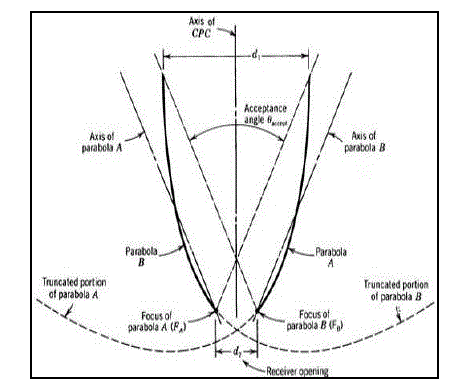 |
| The angle between the axis of the CPC and the line connecting the focus of one of the parabolas with theopposite edge of the aperture is the acceptance half angle (θc). The reflector profile is designed and fabricated for a half acceptance angle (θc= 11.54°). Angle 2θc is the acceptance angle of 2-D CPC.The distance between GF and AB is the full height of CPC.The absorber AB is flat and parallel to aperture GF.Some rays directly fall on the absorber and some fall on the absorber after reflection from the reflector. |
| Aperture Area = W* L |
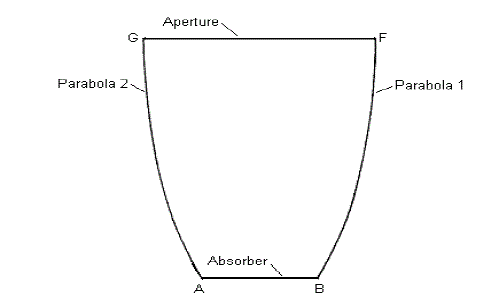 |
| The geometry of an ideal two dimensional CPC is shown in fig .1[5].The concentrator consist of two segments AG and BF which are the parts of two parabolas 1 and 2 .GF is the aperture of width W and AB is the absorber surface of width b. The concentration ratio is also given by C = ( W/b ). It can be shown that ( W/b ) = ( 1/sin θc) and that this concentration ratio is the maximum possible for the acceptance angle 2θc [5].The cross section of CPC with flat plate absorber is shown in fig. 2.This is the simplest type of CPC.The full 2-D CPC is shown in fig. 3.It consist of two parabolic reflectors ,which funnel the radiation from aperture to absorber. The left and right reflectors belong to different parabolas and hence it is known as compound parabolic concentrator. The focus of parabola 1 is at A and that of 2 is at B.Rabl derived some general relations for full CPC with flat absorber. He derived the expressions for reflector shape, focal length, co-ordinates of end point, total height, and arc length. For truncated CPC also, he derived the expressions for aperture width, height, co-ordinates of end point and arc length [4]. |
| Using the x-y coordinate system shown in fig.1 and by using the equation of parabola the parabola 2 is constructed [5]. |
 |
| Using the values of x and y, a smooth curve is drawn (which gives the right half of the parabola) as shown in Fig.1. The mirror image gives the left half, that result in two-dimensional CPC.Compared to cylindrical parabolic concentrator, a CPC is very deep and requires a large concentrator area for a given aperture. It has been shown that a large portion of the top of a CPC can be removed (truncated) with negligible loss in performance [4]. Thus in practice, a CPC is generally truncated (reduced in height) by about 50 % as the top portion of the reflector does not intercept much radiation.Truncation also reduces the cost of CPC. A lot of reflector material is saved by truncation with only a little loss in CR (Concentration Ratio).The new CR after the truncation is given by |
| C =Aperture width after truncation / Width of the absorber |
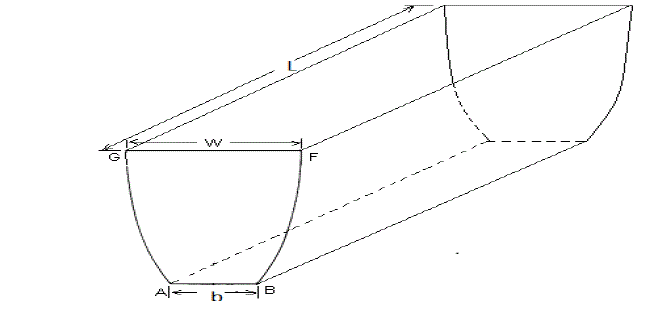 |
| By truncation, acceptance of both beam and diffuse radiation increases. Truncation is done by drawing a horizontal line across the reflector at the selected height and discarding the part of the curve above that line. The shape of the reflector below the cut-off line is not changed. So the acceptance angle 2ïÃÂñc of the truncated CPC remains the same as that of a full CPC from which it is truncated. |
| The important advantage of this type of CPC is that they do not require continuous tracking when oriented in east –west direction. When concentration ration is 2 to 10 a few number of tilt adjustment is required throughout the year.CPC can collect both direct and diffuse radiation. |
IV. FABRICATION OF CPC |
| For the selected CPC, the size of the reflector, material requirement, cost etc. can be decided in advance before fabrication.This CPC is fabricated with proper selection of the material of different components. The property values of the material is taken from the literature.The dimensions ïÃÂñc,W and b are selected with proper considerations. |
| The basic dimensions: |
| ïÃâ÷ Aperture width = 100 cm |
| ïÃâ÷ Absorber width = 20 cm |
| ïÃâ÷ Total Height = 294 cm |
| ïÃâ÷ Length of the collector L is selected as 120 cm |
| ïÃâ÷ C=100/20=5 |
| After 2/3 Truncation of full height, |
| ïÃâ÷ Aperture width =86 cm |
| ïÃâ÷ Truncated height = 98 cm |
| ïÃâ÷ C = 86/20 = 4.3 |
| The full scale drawing of this truncated CPC is prepared on a large drawing paper by using the co-ordinates.A CPC with dimensions so arrived at is fabricated. The procedure for fabrication and the necessary instrumentation are described. |
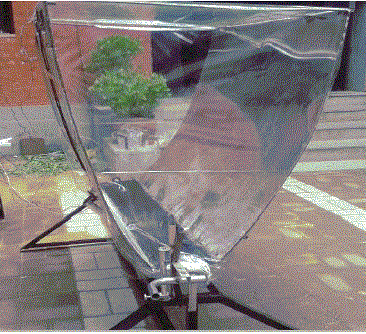 |
| Material selection and dimension for various components is described here. Absorber |
| The MS (mild steel) plate which can transfer maximum amount of heat through it is used as absorber. The dimensions are b = 20 cm, L= 120 cm. It is painted black from outside to have high absorptivity. |
Aperture |
| The glass tube of Borosil is used as aperture to the absorber. It is a low iron glass of high transmissivity. |
Reflector |
| The SS sheet is used for the reflector. It has high reflectivity. |
Side Covers |
| The top cover is also a low iron glass sheet. Two side acrylic sheet covers are provided to reduce convection loss and not to allow the dust, which may spoil the reflector surface. |
Fabrication process |
| full scale drawing of the reflector shape is prepared on a large size paper. Two SS sheets of the required dimensions are taken for two reflector surfaces. Six m. s. strips having width 1” and thickness 1/8” are bent into the shape of the reflector using the full scale drawing. Now one reflector is fixed onto the three strips with a large number of s. s. rivets. Similarly the other reflector is fixed on the other three strips. (See Fig. 4) The opposite strips are welded with each other at the bottom such that the width of the collector at the aperture is 86 cm. At the aperture, two rods, one on each side, are welded to maintain the aperture width constant. A thermocouple is fixed on the reflector surface to measure its temperature Tm. A small clearance of 5 mm is provided between the glass envelope and the reflector for alignment purpose. So, the reflector portion of 5 mm height near the envelope is removed to have this clearance. A m. s. pipe of enough length is welded at the bottom of the reflector unit projecting out on |
| The frame for the support of reflector is fabricated and the two small m. s. pipe pieces, one at each end, are welded on its both sides. These pieces will work as the bearings for the reflector axis. The reflector axis is inserted into these bearings. Thus the reflector is now supported in bearings and is free to rotate around the axis on either side. A bolt is provided in one bearing to fix the reflector in any position. Also a handle is provided at the end of the axis on one side to easily tilt the reflector. A scale is provided on the stationary support so that the tilting and fixing of the reflector can easily be done in a required position. both side. This pipe is to be used as the axis around which the reflector frame is to be tilted as per the tracking requirement. |
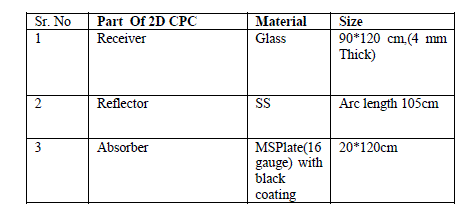 |
CONCLUSION |
| In this thesis, the design and development of 2-dimensional non-imaging type CPC with flat plate absorber and having two parabolic reflectors is attempted. It seems to be far better than flat plate collector and the focusing type collector like simple parabolic concentrator. Following advantages are concluded for 2-D CPC: |
| 1. There are many practical applications where moderate temperature (not very high or low) is required. Such applications are water heating, steam generation, industrial process heating, pumping of ground water, power generation and many more. The temperature needed for such application is about 100 ïÃâðC. CPC is most suitable for this purpose. Even when it is non-evacuated and without any selective surface coating, it can attain the temperature up to 100 ïÃâðC and higher. |
| 2. Flat plate collector may attain the temperature up to 90 ïÃâðC. This puts the limitations on most of the moderate temperature applications. |
| 3. CPC can also attain higher temperatures up to 200 ïÃâðC to 300 ïÃâðC at higher concentration ratio or when it is evacuated between absorber and envelope and the selective coating is applied on absorber surface or by using some special modifications. |
| 4. Focusing type simple parabolic concentrator needs a continuous tracking of the sun, so the costly arrangement for tracking device is required, whereas for CPC, no continuous tracking is needed. It requires only a few tilt adjustments per year. |
| 5. No diffuse radiation is accepted by simple parabolic concentrator, while a significant fraction (= 1/C) of diffuse radiation is accepted by CPC. |
| 6. Due to smaller size of absorber in CPC, loss coefficient and hence losses are less as compared to that in FPC. |
V. FUTURE SCOPE |
| Optical and thermal analysis for this fabricated 2-D CPC will be done for performance investigation.The observations on the fabricated CPC will be taken for the days together and the experimental results will be compared with the predicted results and also with the similar results reported by other investigators in literature.Conclusions will be drawn on the basis of these comparisons and further scope of the work will be defined. |
References |
|